![]()
![]()
![]()
Use LEFT and RIGHT arrow keys to navigate between flashcards;
Use UP and DOWN arrow keys to flip the card;
H to show hint;
A reads text to speech;
31 Cards in this Set
- Front
- Back
|
Lobe-fin fishes
|
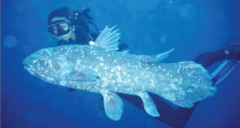
Include two living groups that have some characteristics of the hypothetical first terrestrial verterbrates
|
|
|
Lobe-fin fishes include
|
coelacanth, Latimeria, a fish within the Actinistia with paired fins at the end of appendages with internal bony elements (rather than the fin rays of the Actinopterygii)
|
|
|
notochord; jointed braincase
|

In addition to the presence of fins supported by substantial skeletal elements, coelacanth retain the _______ as the primary anterior-posterior support and the primitive trait of a ___________.
|
|
|
into the early 1900's it was thought that the coelacanth....
|
had been extinct for 65 million years
|
|
|
lungfishes
|
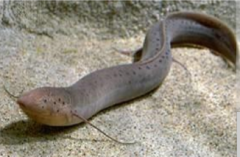
retain a prominent notochord but have well-developed vertebrae as well.
-have functional lungs and can withstand drying of their habitat |
|
|
estivation
|
lungfish can enter __________, a state of reduced physiological activity during drought, for 7 to 8 months
-air breathe -lower heart rate -retain urea and other wastes -catabolize body, lose weight |
|
|
tetrapod
|
chordate living on land
-are the ancestrally terrestrial and four limbed vertebrates. Amphibia is the earliest diverging living group |
|
|
O2 is more concentrated
|
in air than in water
|
|
|
air is
|
1000 times less dense and 50 times less viscous than water
-experiences far greater temperature extremes |
|
|
terrestrial environments
|
comprise a much greater diversity of habitats than do marine environments
|
|
|
vascular plants diversified during
|
the Devonian Period
-competition and predation increased |
|
|
Origins of tetrapods: Osteichthyes (Osteolepiformes)
|
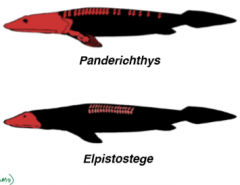
-tetrapod skull roof and cheekbones
-stronger axial skeleton -paired fins with single basal two distal elements -choanae (internal nostrils) |
|
|
choanae
|
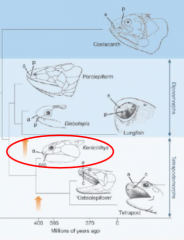
-internal nostrils
-openings in the roof of the mouth connecting to the external nostrils -this arrangement allows air to be drawn into the lungs even when the mouth is closed |
|
|
Aquatic tetrapods
|

-appear following Kellwasser
-Fusion of bones to form stronger pelvis -vertebrae braced against each other -pectoral girdle detached from the back of the skull -dactyly (development of fingers) |
|
|
modern amphibians
|
-there are over 6,000 species of predatory salamanders, frogs, and caecilians
-skeleton is mostly bones (rather than cartilage) -usually amphibians have four limbs -skin is moist and functional in respiration |
|
|
amphibians exhibit three distinct body forms
|
-order urodela
-order anura -order apoda |
|
|
salamanders
|
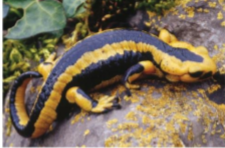
order urodela
-tailed amphibians -abundant in north temperature regions -like all amphibians they have a low metabolic rate and therefore ectothermic |
|
|
frogs
|
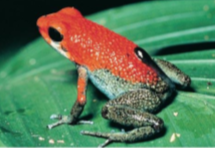
order anura
|
|
|
caecillians
|
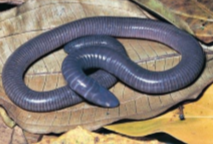
order apoda
|
|
|
ectothermic
|
can't regulate body temperature via metabolic heat production
|
|
|
some salamanders are
|
aquatic and terrestrial
-the ancestral condition is metamorphosis from aquatic larva to terrestrial adults -salamander eggs are fertilized internally by sperm passed to the female in a packet or spermatophere |
|
|
newts
|

have aquatic larva followed by a terrestrial juvenile stage then by a second adult aquatic stage
|
|
|
paedomorphosis
|
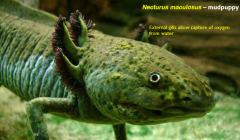
-evolution of retention of larval characteristics into adulthood. Many salamanders achieve sexual maturity while retaining external gills and an aquatic habitat
-external gills allow capture of oxygen from water |
|
|
cutaneous respiration
|
extensive nets of blood vessels in the skin allow for _______ in all amphibians
-at varius life stages salamanders may have gills, lungs, both or neither |
|
|
ballistic tongue protection
|
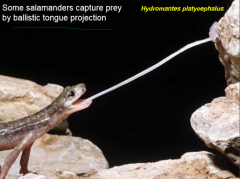
some salamander capture prey by...
|
|
|
frogs and toads (anurans)
|
-over 5,200 species primarily adapted to jumping locomotion (reduction of vertebrae, fusion, and elongation of bones)
-anrans have an outer skin layer toughened by the protein keratin -mucous glands in the skin limit water loss and toxin glands function in defense |
|
|
anuran circulation
|
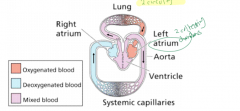
anurans have an efficient, closed circulatory system with a three-chambered heat and separate pulmonary (lung) and systemic (body) circuits.
|
|
|
anuran reproduction
|

-anurans have external fertilization of typically huge masses of eggs deposited in aquatic habitats
-the larval tadpoles first have external than internal gills, the full process of metamorphosis takes 2-3 years in some species |
|
|
caeclians (apodans)
|
~170 species of elongate, limbless, burrowing amphibians
-most species are blind and rely on sensory tentacles on the snout to find worm and insect prey -fertilization of eggs is internal and larval development may occur in the egg, in an aquatic habitat or within the body cavity (viviparity) |
|
|
amphibian declines
|
many amphibian species have gone extinct in the last 20 years, at least 40% of species are in decline
|
|
|
causes of decline include:
|
-habitat destruction
-introduced species -climate change -atmospheric UV radiation -chemical contaminants -disease (fungal pathogens-chytridiomycosis) |

